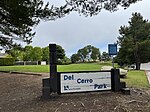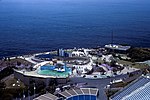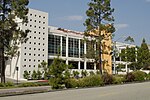Wayfarers Chapel
20th-century Swedenborgian church buildingsBuildings and structures on the National Register of Historic Places in Los Angeles County, CaliforniaChapels in the United StatesChurches completed in 1951Churches in Los Angeles County, California ... and 6 more
Churches on the National Register of Historic Places in CaliforniaModernist architecture in CaliforniaNational Historic Landmarks in CaliforniaPalos Verdes PeninsulaSwedenborgian churches in CaliforniaUse mdy dates from June 2022

Wayfarers Chapel, or "The Glass Church" located in Rancho Palos Verdes, California, has unique organic architecture sited on cliffs above the Pacific Ocean. Affiliated with the Swedenborgian Church of North America, it serves as a memorial to the 18th century scientist and theosopher, Emanuel Swedenborg.
Excerpt from the Wikipedia article Wayfarers Chapel (License: CC BY-SA 3.0, Authors, Images).Wayfarers Chapel
Palos Verdes Drive South,
Geographical coordinates (GPS) Address Nearby Places Show on map
Geographical coordinates (GPS)
| Latitude | Longitude |
|---|---|
| N 33.743638888889 ° | E -118.37775 ° |
Address
Palos Verdes Drive South
90275
California, United States
Open on Google Maps









